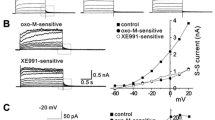Abstract
The aim of the present study was to characterize the muscarinic receptor subtype mediating nonadrenergic noncholinergic (NANC) relaxations in the rabbit anococcygeus muscle (RAM) by the use of muscarinic receptor agonists and a battery of key muscarinic antagonists. In addition, experiments were carried out to identify the NANC neurotransmitter(s) involved in the inhibitory NANC neurotransmission. In preparations with histamine-raised tone, the non-selective muscarinic agonists (pD2 values) (+)-muscarine (5.23), cis-dioxolane (5.16), oxotremorine M (4.95) and carbachol (4.06) produced concentration-dependent relaxations corresponding to 72.6–85.0% of the histamine-induced precontraction. In contrast, the subtype-preferring (M1/M4 over M2 and M3 receptors) agonists 4-(3-chlorophenylcarbamoyloxy)-2-butynyltrimethylammonium chloride (McN-A-343), (S)-4-(dimethylamino)-1-methyl-2-butynyl-N-(3-chlorophenyl)carbamate methobromide [(S)-BN 228], (R)- and (S)-N-methyl-N-(1-methyl-4-pyrrolidino-2-butynyl)acetamide [(R)- and (S)-BM 5] showed no or rather low [(S)-BN 228] muscarinic activity. The low potencies, together with the ineffectiveness of some agonists, indicated a low effective receptor reserve associated with the relaxant response. No contractile responses to (+)-muscarine were observed neither in unstimulated nor in precontracted preparations suggesting that the existence of an excitatory postjunctional muscarinic receptor may be excluded. The nicotinic antagonist hexamethonium had no influence on relaxant responses to (+)-muscarine, but abolished relaxations elicited by (–)-nicotine. This demonstrates that the RAM contains also nicotinic acetylcholine receptors (AchRs) mediating inhibitory NANC responses. Relaxations induced by the stimulation of muscarinic and nicotinic AchRs as well as by electrical field stimulation (EFS) were completely abolished by tetrodotoxin and were also sensitive to the nitric oxide (NO) synthase inhibitor NG-nitro-L-arginine (L-NOARG), indicating that NO plays an important role as an inhibitory NANC transmitter in RAM. All muscarinic antagonists investigated did not influence the histamine-induced precontraction, but shifted the concentration-response curve of (+)-muscarine to the right in a parallel fashion. Schild analysis yielded regression lines of unit slope, indicating competitive antagonism. The following rank order of antagonist potencies (pA2 values) was found: 11-({4-[4-(diethylamino)-bu-tyl]-1-piperidinyl}-acetyl-5,11-dihydro-6H-pyrido (2,3-b) (1,4)-benzodiazepine-6-one hydrochloride (AQ-RA 741; 8.08) = himbacine (8.03) ≥ tripitramine (7.69) ≥ p-fluoro-hexahydro-sila-difenidol (p-F-HHSiD; 7.48) ≥ methoctramine (7.30) ≥ pirenzepine (7.18) ≥ guanylpirenzepine (6.24). A comparison of the pA2 values determined in the RAM with published data from binding studies at muscarinic M1–M4 and m5 receptors suggests that the functional muscarinic receptor mediating NANC relaxation in the RAM is of the M4 subtype. Taken together, the results obtained in the present study provide convincing evidence that relaxant responses elicited by muscarinic stimuli in RAM are nitrergic in nature and mediated by muscarinic M4 receptors located somadendritically on NANC neurons. Thus, the isolated RAM may serve as a functional muscarinic M4 receptor model.
Similar content being viewed by others
Author information
Authors and Affiliations
Additional information
Received: 4 March 1997 / Accepted: 24 June 1997
Rights and permissions
About this article
Cite this article
Gross, J., Mutschler, E. & Lambrecht, G. Evidence for muscarinic M4 receptors mediating nonadrenergic noncholinergic relaxations in rabbit anococcygeus muscle. Naunyn-Schmiedeberg's Arch Pharmacol 356, 505–516 (1997). https://doi.org/10.1007/PL00005084
Issue Date:
DOI: https://doi.org/10.1007/PL00005084




